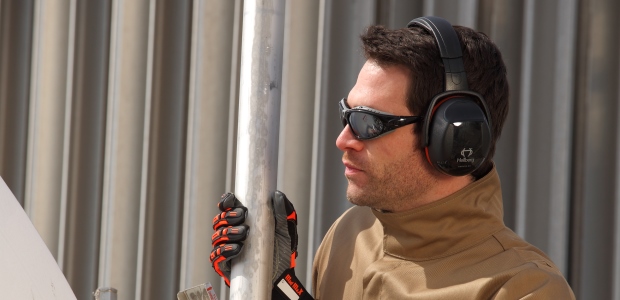
Guide to Selecting the Right Ear Muff
When combining hearing protection with safety glasses, face masks, etc., ensure performance is not adversely affected.
- By Gary Klee, Colin MacKenzie
- Jun 01, 2015
Wearing hearing protection can mean the difference between enjoying the sounds of everyday life and a lifetime of disability. Every day, we are exposed to potentially hazardous environmental noise. It is, therefore, critical that workers who must be present where the noise level is high and constant select either a muff or plug protector to reduce the noise level to an acceptable level. We will now discuss the factors you should consider when selecting the correct ear muff for the job.
Step 1: Determining Your Noise Level
Is the noise level and frequency content known (dB and Hz)?
If not, see the list of common noise sources on the next page. On some machines and power tools, you can find the dB level in the user manual or stated on a label on the machine.
If yes, follow this example: It is recommended that the calculated level under the ear muff should be under 85 dB (A). Therefore, subtract 85 dB from the noise level dB to find out the minimum protection level needed. The key is to provide enough attenuation but not enough to overprotect the wearer. Understand your whole-shift noise exposures and select the ear muff on the basis of that exposure, and do not use the highest measured noise level as your guide.
Example:
If you use a chainsaw, and the dB level is 110 dB (A). The recommended level under the ear cup should be below 85 dB (A). Therefore, you need an ear muff with an attenuation of at least 25 dB (110–85 =25).
When to consider selecting an ear muff with a lower protection level:
- Is the exposure time shorter than four hours? The ear muff protection level is based on noise exposure over an eight- hour working day. If the exposure is shorter, you should consider selecting a lower protection level.
- Do you need to hear important information from colleagues, warning signals etc.? Consider selecting a lower protection level or use an electronic level dependent ear muff.
- Are you suffering from hearing loss? If you have a hearing impairment, you may already have difficulty understanding speech in noisy environments. If you select the highest attenuation for hearing protectors, you may find it even more difficult to communicate or hear warning alarms.
When to consider selecting an ear muff with a higher protection level:
- Does the noise consist mainly of low-frequency noise? If the noise is mainly low frequency, you should consider selecting a higher protection level because low-frequency noise is more difficult to block out.
- Do you need to wear safety glasses, face masks etc.? When combining hearing protection with safety glasses, face masks, etc., ensure performance is not adversely affected. If you are uncertain, seek additional advice and guidance or select an ear muff with a slightly higher protection level.
- Are there any other noise sources nearby? If there are other noise sources nearby, you should consider selecting a higher protection level.
Step 2: Choose the Correct Ear Muff Style
- Are there any requirements to wear a hard hat at your workplace? If so, select a cap-mounted ear muff. Make sure that the hard hat you choose has universal slots that can be used in combination with the selected ear muff.
- Do you need to wear a bump cap or a hat for sun protection? Neckband ear muffs can be worn around the back of the neck, so users can wear them with bump caps, full-brim hard hats, or hats without attachment slots.
Step 3: Other Requirements
- Is the noise intermittent, or do you move in and out of noisy areas? Consider selecting an electronic level-dependent ear muff. The level-dependent ear muff protects against impulsive or intermittent hazardous noise while allowing situational awareness.
- Are you working with monotonous or stationary work tasks without the need to hear warning signals, etc.? Select an ear muff with a built-in AM/FM radio. Employees who wear radio ear muffs are more productive and motivated on the job.
- Are you working with monotonous work tasks and need to hear warning signals, etc.? Select an ear muff with both AM/FM radio and a level-dependent hearing function.
Common Noise Sources
Below are examples of different noise sources with their approximate sound pressure level in dB(A). These examples should only be used as guidance, as large variations may occur. The distance and surroundings also will affect the noise level.
Noise Source
|
dB(A) |
Frequency |
Electric hedge trimmer
|
90 dB
|
Mid-High |
Concrete mixer
|
94 dB
|
Low |
Concrete breaker
|
102 dB
|
Low |
Punch press
|
105 dB
|
Mid-High |
Jackhammer (pneumatic)
|
120 dB
|
Mid-High |
| Shotgun |
158 dB
|
Mid-High |
Rifle (30 calibers)
|
169 dB
|
Mid-High |
This article originally appeared in the June 2015 issue of Occupational Health & Safety.